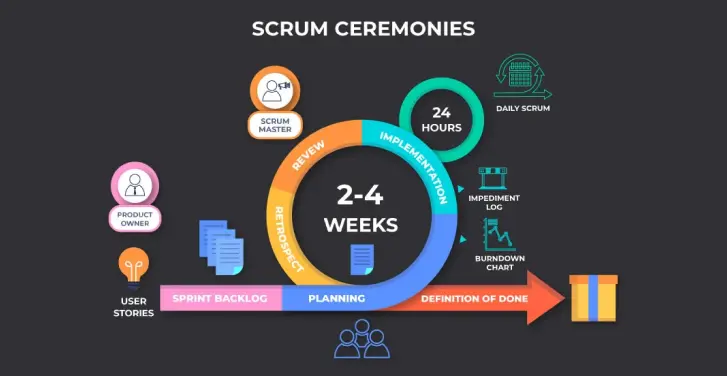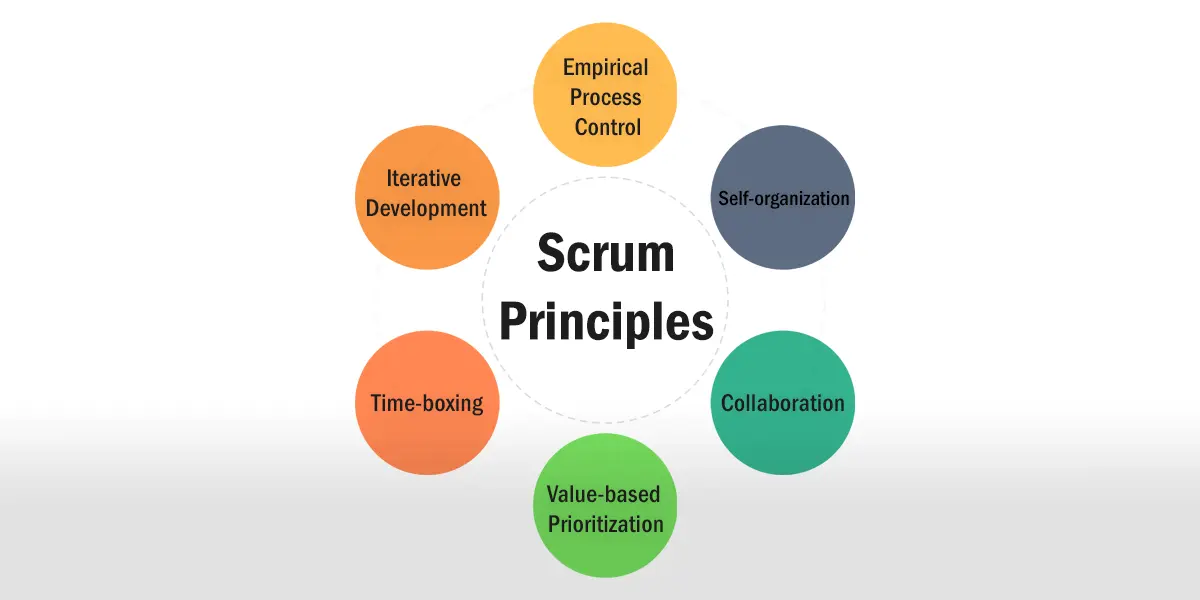Scrum is a growing framework and more and more organizations are opting for this framework for their Project Management
Processes. The need for Scrum Masters is growing quickly as more businesses adopt agile approaches. Companies all over the world are giving
Scrum Masters quite the appreciation and high salary perks for guiding the teams through agile projects.
In this guide, we will take you through everything you need to learn about Scrum and Scrum Framework.
What is Scrum?
Scrum is an agile software development methodology that relies on incremental and iterative methods.
Scrum is an agile framework that is meant to offer value to the customer throughout the project's development.
Scrum enables teams to learn from experiences, self-organize while working on a problem, and reflect on their victories and losses to continuously improve.
What is The Scrum Framework?
The Scrum Framework is heuristic; it
is built on continual learning and adaptation to changing circumstances. It recognises that the team will learn
from experience and that they do not have all the answers at the beginning of a project.
With re-prioritization integrated into the process and brief release cycles, Scrum is designed to enable teams
automatically adapt to changing conditions and user requirements so your team can continuously learn and develop.
Therefore, the Scrum Framework directs Product Development,
emphasising value and strong visibility of progress. A Scrum Team uses the Scrum Framework to create that product from an idea by working
from a dynamic list of the most important tasks.
What are Scrum Ceremonies or Events?

The series of sequential actions that Scrum Teams take on a regular basis, are the Ceremonies or Events and is one of the more well-known elements of the Scrum Framework.
When working on a project, Scrum Ceremonies are a wonderful method to move swiftly and make changes as needed. It's crucial to remember that these
Ceremonies are unique to the Scrum Framework.
Here is a list of key Ceremonies or Events that a Scrum Team is involved in:
1. Organize The Backlog
Backlog organisation also referred to as Backlog Grooming, is the Product Owner's responsibility. The primary
responsibilities of the Product Owner are to steer the Product in the direction of its product vision and to
maintain a continual eye on the customer and market.
To help prioritise and keep the list organised and prepared for work at any moment, he or she updates it utilising input from users and the development team.
2. Sprint Planning
The entire development team plans the work that will be done (scope) during the current
Sprint during this Sprint Planning meeting. The team decides on the Sprint Goal during this
meeting, which is facilitated by the Scrum Master.
The Product Backlog is then used to add specific user stories to the Sprint. These stories are always in line with the
objective and are deemed realistic for implementation during the Sprint by the Scrum team.
3. Sprint
The real-time frame during which the Scrum Team collaborates to complete an increment is called a Sprint. A Sprint
typically lasts two weeks, however, some teams find that a week or even a month makes it simpler to produce a worthwhile increment.
From planning to retrospectives, everything takes place throughout the Sprint. Once a Sprint's duration has been determined, it must remain constant for the duration of the development phase.
4. Daily Scrum or Stand-up Meeting
The Scrum Master often hosts a 15-minute stand-up meeting called Daily Scrum
to coordinate team members' work, such as what was accomplished yesterday and what needs to be done today, identify any obstacles,
and create visibility for everyone's work in the Sprint.
5. Sprint Review Meeting
A Sprint Review Meeting is held at the end of every Sprint. To ensure that the supplied increment
satisfied the business need and to update the Product Backlog in light of the comments, it is important to get input from the Product Owner and other
stakeholders.
This feedback will then be turned into items that are added back into the Product Backlog, where the team can buy and incorporate them during a subsequent Sprint.
6. Sprint Retrospective Meeting
We use Retrospectives, which usually take 90 minutes, to help us build constant improvement into our team culture and Sprint cycle.
The Scrum Team gathers at this time to discuss their most recent Sprint and consider how to grow as a unit by considering what worked well,
what didn't, and what may be improved. It enables the team to concentrate on its overall performance and formulate ideas for ongoing development.
What are Scrum Artifacts?
Scrum Artifacts are created to ensure that important information is transparent when making decisions. Here’s an overview of the
three artifacts in Scrum:
Product Backlog (PB)
The product backlog is a collection of all the requirements a product must have in order to
satisfy potential buyers. The Product Owner creates it, and the functions are ranked in order of
greater and lesser importance to the company. The Product Owner should provide a solution to the question, "What should be done?"
Sprint Backlog (SB)
The
Sprint Backlog is a subset of the Product Backlog that is chosen by the team to be
completed during the Sprint they will be working on. The team decides how long each Sprint will
last. A physical board known as a Scrum board is typically used to show the Sprint backlog, making the development process accessible to anybody entering the work area.
Increment
The total of all the tasks, use cases, user stories,
product backlogs, and any other component generated during the Sprint and to be made available to the end user in the form of software is the increment.
Three Scrum Roles and Responsibilities
Let us take a look at the three Scrum roles and responsibilities.
What are The Three Scrum Roles?
The Scrum Master, the Product Owner, and the Development Team make up a Scrum team. There is just one Scrum Master
and one Product Owner, although there are typically multiple members of the development team. To understand the
responsibilities of each of these Scrum roles, you can refer below.
1. Scrum Master
A Scrum Team must follow the Scrum values as closely as possible, and the Scrum Master is in charge of making
sure this happens. This implies that they steer the team toward its goals, organise and conduct meetings, and resolve any challenges the group may encounter.
Additionally, Scrum Masters may take on more responsibility inside an organisation to assist in integrating Scrum ideas into daily
operations. They are frequently referred to as the "servant leader" of the Scrum team because they are both a leader and a
behind-the-scenes supporter. A Scrum Master may be in charge of the following tasks:
- Organize daily standups, often known as Scrum meetings.
- Organize Sprint planning sessions
- To determine what worked well and what may be improved for the upcoming Sprint, do "Retrospective" reviews.
- Arrange individual meetings or other forms of contact to stay in touch with the team members.
- Communicate with stakeholders outside the team to manage challenges the team faces.
2. Product Owner
A Product Owner ensures that the Scrum Team is working toward the same overall goals. They are aware of the Product's Business requirements,
including market developments and client expectations. Product Owners frequently communicate with product managers and other external
stakeholders because they need to know how the Scrum team fits into larger objectives.
The following responsibilities may fall on the shoulders of Product Owners:
- Assign tasks to manage the product backlog according to priority.
- Set the team's product vision.
- Communicate with outside parties and convey their needs to the group
- Make sure the team is concentrated on meeting product needs by communicating with them and monitoring their progress.
3. Development Team
A development team is made up of experts who carry out the practical work of finishing the tasks in a Scrum Sprint.
As a result, members of the development team can play any necessary job to accomplish the Sprint goals,
including computer engineers, designers, writers, and data analysts. The development team typically works together
to establish objectives and strategies for accomplishing them rather than passively waiting for orders.
The development team may be given the following tasks:
- Assisting with goal-setting and Sprint planning
- Contribute knowledge to product programming, design, or improvement
- Utilise data to identify development best practices.
- Prototypes and test items, as well as other methods of quality control
What Are the Advantages of Scrum Framework?
A Scrum is an Agile Approach that gives teams a plan for completing tasks incrementally. Scrum
is increasingly utilized across sectors like product development, manufacturing, and construction
even though it was originally developed for software development. Listed below are some of the advantages of the Scrum Framework:
- Faster Delivery
Scrum can lead to quicker delivery and an earlier launch date because the objective is to generate a functioning product with each Sprint.
- Increases Client Satisfaction
Greater customer satisfaction results from higher quality work. At the end of each Sprint,
clients can evaluate the product and provide feedback to the team. Changes can be done fast and easily since Scrum is adaptable.
- Reduced Costs
Scrum can help firms save money since it requires less control and documentation. The Scrum team may become more productive as a result, wasting less time and effort.
- Increases Employee Morale
Every Scrum Team member bears full responsibility for their job, and the Scrum master is there
to support them and shield them from outside pressure. Team members are empowered and inspired to provide their best work as a consequence.
- Flexible and Adaptable
The core of the Scrum Framework is adaptation. It is appropriate for circumstances in which the requirements and scope
are not clearly specified. Changes can be readily incorporated without harming the project's outcome.
Scrum Pillars, Values, and Principles
What is Empiricism in Scrum?
Working on the basis of facts, experience, and evidence is what Empiricism implies. Scrum uses an
Empirical Method in which developments are based on observations of reality rather than made-up plans. For organisational
and business agility, Scrum also emphasises mindset and cultural change.
Three Pillars of Scrum
The three pillars that are supporting the Scrum Framework are as follows:
1. Transparency
- It is the act of stating the truth as it is. Everyone involved is open and honest in their daily interactions with others, including the client, the CEO, and individual contributors.
- They all have confidence in one another and the bravery to inform one another of both good and negative news. No one has a secret motive; everyone works toward and together achieves the shared corporate goal.
2. Inspection
- When we talk about Inspection, we don't just mean an Inspection by an inspector or an auditor; we mean an Inspection by the entire Scrum Team. The product, procedures,
personnel characteristics, practices, and ongoing improvements are all subject to examination.
- For instance, the team displays the product to the client in an open and transparent manner at the end of every Sprint to get insightful feedback. If the customer
modifies the requirements throughout the inspection, the team adapts and uses this as an opportunity to work with the customer to clarify the criteria and test the new hypothesis rather than complaining.
3. Adaptation
- The ability to adjust based on the findings of the inspection is referred to as adaptation in this context. Is our current situation better than it was yesterday? is a
question that everyone in the organisation must ask frequently. For organisations that operate for profit, value is expressed in terms of profit.
- The adaptation should eventually circle back to one of the motivations for adopting Agile, such as shorter time to market, higher return on investment through value-based
delivery, a lower total cost of ownership due to improved software quality, and increased satisfaction among customers and employees.
What Are Scrum Values and Principles?
Scrum provides a code of ethics and conduct standards for Scrum teams and is based on a set of core values. Teams are given guidelines for behaviour to uphold and adhere to
when utilising Scrum via the Scrum ideals.
On the other hand, the key rules for integrating the Scrum Framework into your company are known as the Scrum principles.
The rules are laid down in the Scrum Body of Knowledge (SBOK), and they cannot be changed. Everything is at stake.
What Are The Five Scrum Values?
As per the Scrum Guide, listed below are the five Scrum Values:
1. Focus
Time-boxes are used to divide up Scrum projects. Scrum teams therefore have one to four weeks to produce a required product increment. To accomplish their objectives
as rapidly as possible, the team members must give their full attention to this requirement. Distractions are unfortunately everywhere, and some of them could even appear
urgent enough to deal with right away. But throughout the project, Scrum team members must remain focused on the goal and the power.
2. Openness
Stakeholders in the project and members of the Scrum team must maintain clear and honest lines of communication. When discussing the necessary workload and the
difficulties it presents, both parties should engage in complete disclosure. All parties develop trust as a result of this transparency. Another aspect of this value is being adaptable.
3. Commitment
The Scrum team makes a personal commitment to attaining its objectives. This dedication goes beyond merely agreeing to meet deadlines and other standards. Even though
achieving deadlines is a part of the commitment, the scope goes much further than milestones to encompass the organization's overarching cause and vision. It is a dedication
to education, excellence, giving their all, and the team and its cooperation.
4. Courage
Team members need to have the guts to take on difficult, intimidating challenges and act morally. Choosing a safe path and avoiding hazards is simple. Unluckily, a team
lacking in courage won't be inventive, imaginative, or successful. Members of Scrum teams need to be unflappable in the face of challenging obstacles.
5. Respect
Each member of a Scrum team must respect the views, backgrounds, and cultural traditions of others. Respect for one another helps the Scrum team members bond and
works together more effectively. Members must extend this respect to the users as well, paying attention to their issues and complaints and making sure the final product satisfies them.
What Are the Six Scrum Principles?
For the Scrum Framework to be properly applied, there are six guiding principles. All of them must be used, without failure. Refer below to learn about these
6 Scrum principles.
1. Empirical Process Control
Transparency, inspection, and adaptation serve as the cornerstones of the Scrum methodology. Scrum decisions are made on observation and experimentation rather
than a comprehensive, explicit plan.
2. Self-Organization
When Scrum team members self-organize instead of being micromanaged and driven by the head, they produce more. A Scrum team that is independent will have greater
buy-in and shared ownership. This idea generates an environment that encourages innovation and creativity.
3. Collaboration
The three essential qualities of awareness, articulation, and appropriation make up the collaboration principle. In accordance with this notion, project management
is also characterised as a shared value-creation process that depends on collaboration and interaction among teams to yield the best outcomes.

4. Value-Based Prioritization
The Scrum Team must rate tasks according to their significance and value to both the final users and business objectives. Starting with the project's beginning and
continuing until it is successfully finished, this prioritisation process is one that is constantly changing.
5. Time-Boxing
Time is a scarce, valuable resource. The time-boxing principle plans and allots a specific amount of time for the various tasks. Setting aside time for management
of the project's planning and execution improves efficiency. The time-boxed components of Scrum include:
- Sprints: (2-4 week release cycles connected to work)
- Planning sessions for Sprints: (1-2 hours for task determination)
- Daily stand-up sessions: (about 15 minutes long for task discussion and monitoring)
- Sprint review meetings: (1–2 hour evaluation of tasks and release cycles)
6. Iterative Development
Scrum Project requirements must always be adjusted and revised since they are constantly changing and evolving.
This principle focuses on how to handle these changes more
successfully and productively, leading to products that better meet the needs of the client.
Conclusion
In this guide, we have discussed the importance of the Scrum Master in bringing the Scrum Framework into business. There is a growing need
for Scrum Masters as more firms use Scrum's concepts and principles to accomplish their goals.
If you are planning your Scrum master journey, then the first step is to grasp what Scrum is all about and then opt for a Scrum Master Certification.
About Author

Abhishek Srivastava
-Senior IT Professional , CBAP Certified
Abhishek Srivastava is a seasoned IT professional with diverse experience in Banking, Insurance, Utility and Education domains.
Managing large accounts, Program management & Business Analysis has been his forte, having done so for customers like ICICI Bank,
NTPC & many other International customers.
In the past, he has been associated with companies like Mastek and 3i Infotech Ltd (erstwhile ICICI Infotech Ltd). An NIT (Erstwhile REC)
/ IIM Kozhikode graduate, now as an entrepreneur, he is pursuing his dream of creating an organization for providing quality training
in the fields of Project Management and Business Analysis. His other areas of interest are Business Analysis consulting and mentorship.
Over the years, he has mentored and guided more than 1000 professionals



